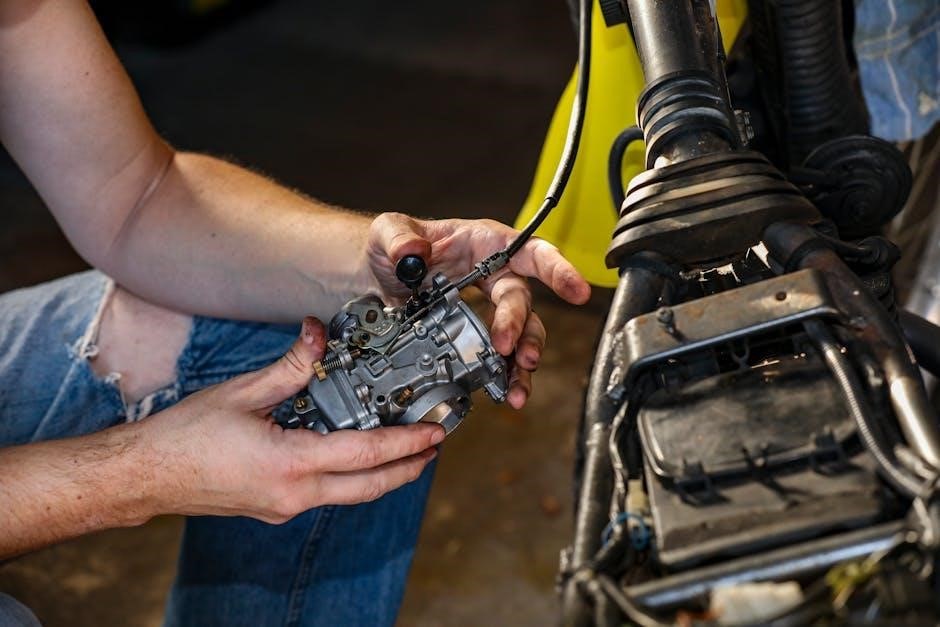Welcome to the Panasonic Lumix DMC-ZS100 manual, your comprehensive guide to mastering this versatile camera. This manual provides detailed insights into its features, setup, and operation.
1.1 Overview of the Camera and Its Key Features
The Panasonic Lumix DMC-ZS100 is a compact point-and-shoot camera featuring a 1-inch MOS sensor, 25-250mm zoom lens, and 4K Ultra HD video capabilities. It includes an electronic viewfinder, RAW image capture, and advanced autofocus. The camera supports 4K Photo and Post Focus modes, allowing for precise control over images. With built-in Wi-Fi and a touchscreen LCD, it offers versatile shooting options for enthusiasts and professionals. Its sleek design and robust feature set make it ideal for capturing high-quality photos and videos in various settings.
1.2 Importance of Reading the Manual for Optimal Use
Reading the Panasonic Lumix DMC-ZS100 manual is essential for unlocking its full potential. It provides detailed instructions on using advanced features like 4K Photo and Post Focus, ensuring you capture stunning images. The manual also guides you through troubleshooting common issues and maintaining the camera. By understanding the settings and functions, you can optimize performance and avoid mistakes. Whether you’re a novice or an experienced photographer, the manual is a vital resource for mastering the DMC-ZS100’s capabilities and enhancing your photography experience.
Understanding the Camera’s Design and Layout
The Panasonic Lumix DMC-ZS100 features a compact, ergonomic design with an electronic viewfinder and a 3-inch touchscreen. Its intuitive controls and zoom lens make it perfect for versatile photography.
2.1 Key Features of the DMC-ZS100
The Panasonic Lumix DMC-ZS100 boasts a 20.1MP sensor, 25-250mm zoom lens, and 4K video capabilities. It includes features like 4K PHOTO and Post Focus, allowing precise control over images. The built-in electronic viewfinder enhances composition, while the 3-inch touchscreen simplifies navigation. Wi-Fi connectivity enables easy sharing, and the camera supports RAW format for advanced editing. Its compact design makes it ideal for travel and everyday use, offering both automatic and manual modes to cater to all skill levels.
2.2 Components and Controls: A Detailed Guide
The DMC-ZS100 features a 25-250mm zoom lens with a manual zoom lever for precise control. The top includes a mode dial, shutter button, and power zoom lever. Rear controls include a 3-inch touchscreen, navigation buttons, and a quick menu button for easy access to settings. The electronic viewfinder provides a clear preview of your shots. Additional controls like the pop-up flash and battery/card compartment are conveniently located for accessibility, ensuring intuitive operation for both beginners and professionals.

Operating the Camera: Basic and Advanced Modes
Master the Panasonic Lumix DMC-ZS100 with its intuitive modes, from Intelligent Auto to Manual, offering creative control. Capture stunning images and videos with advanced 4K features.
3.1 Preparing the Camera for Use
Before using your Panasonic Lumix DMC-ZS100, ensure the camera is properly prepared. Charge the battery fully and insert a compatible memory card. Turn on the camera and navigate to the menu to set the language, date, and time. Familiarize yourself with the mode dial and key controls. For optimal performance, update the firmware if necessary. Finally, adjust the electronic viewfinder and lens settings to suit your preferences. This preparation ensures a smooth and enjoyable shooting experience.
3.2 Basic Shooting Modes and Settings
The Panasonic Lumix DMC-ZS100 offers various basic shooting modes to suit different scenarios. Start with Intelligent Auto Mode for effortless point-and-shoot photography. For more control, use Program AE (P), Aperture Priority (A), Shutter Priority (S), or Manual (M) modes. Scene modes like Portrait, Landscape, and Sports tailor settings for specific subjects. Enable features like 4K Photo and Post Focus to capture sharp images and adjust focus after shooting. Adjust ISO, white balance, and exposure compensation to refine your shots. These modes and settings provide a solid foundation for capturing stunning images with ease.
3.3 Configuring Advanced Settings for Professional Results
To achieve professional results with the Lumix DMC-ZS100, explore advanced settings like 4K Photo and Post Focus. Enable 4K Photo to capture 8MP images from 4K video, allowing precise moment capture. Use Post Focus to adjust the focal point after shooting. For enhanced control, shoot in RAW format to retain maximum image detail. Utilize focus stacking for macro shots and customize controls to streamline your workflow. These advanced features empower you to refine your technique and produce high-quality, professional-grade images with ease and precision.
Troubleshooting Common Issues
Troubleshooting common issues with the Panasonic Lumix DMC-ZS100 involves identifying error messages, resolving connectivity problems, and addressing performance-related concerns for optimal functionality. This section provides solutions to ensure smooth operation.
4.1 Identifying and Resolving Error Messages
Understanding error messages on the Panasonic Lumix DMC-ZS100 is crucial for smooth operation. Common errors include “Card Error” or “Lens Error,” often due to memory card issues or lens obstruction. To resolve these, ensure the memory card is properly formatted and clean the lens gently. If the camera freezes, restart it or reset to factory settings. Refer to the manual for specific error codes and detailed solutions to restore functionality quickly. Regular maintenance and updates can prevent recurring issues. Always follow the manual’s troubleshooting guide for accurate fixes. This ensures your camera performs optimally in all conditions.
4.2 Solving Connectivity and Performance Problems
Connectivity issues with the Panasonic Lumix DMC-ZS100, such as Wi-Fi pairing or Bluetooth problems, can often be resolved by resetting the camera or ensuring firmware is up-to-date. Performance slowdowns may occur due to cached data or outdated software. To address this, reset the camera to factory settings or clear the cache. For battery life concerns, adjust power-saving modes or disable unnecessary features. Regular firmware updates and proper memory card formatting also enhance performance. Refer to the manual for detailed steps to diagnose and resolve connectivity and performance issues effectively. This ensures seamless operation and optimal camera functionality. Always follow the troubleshooting guide for the best results.

Accessories and Maintenance Tips
Explore essential accessories and maintenance tips for your Panasonic Lumix DMC-ZS100. Discover compatible gear and best practices to keep your camera in optimal condition always.
5.1 Compatible Accessories for the DMC-ZS100
The Panasonic Lumix DMC-ZS100 supports a variety of accessories to enhance your photography experience. These include high-quality lenses, filters, and adapters. You can also use external flash units for better lighting control. Additionally, compatible memory cards, such as SD, SDHC, and SDXC, ensure ample storage for your photos and videos. Other accessories like camera bags, tripods, and remote shutter releases are available to improve portability and stability. Always choose Panasonic-approved products to maintain optimal performance and compatibility with your camera.
5.2 Best Practices for Camera Maintenance
Regular maintenance ensures your Panasonic Lumix DMC-ZS100 performs optimally. Clean the lens and LCD screen with a soft, dry cloth to prevent smudges. Avoid harsh chemicals or abrasive materials that could damage the surfaces. Store the camera in a cool, dry place away from direct sunlight. Use the provided lens cap to protect against dust and scratches. Additionally, update the camera’s firmware periodically to access the latest features and improvements. Always handle the camera with care to avoid physical damage and ensure longevity.

Firmware Updates and Software Compatibility
Regularly check the official Panasonic support website for firmware updates to ensure optimal performance and access to new features. Ensure your operating system is compatible with the camera’s software for seamless connectivity and functionality.
6.1 How to Update the Camera’s Firmware
To update the Panasonic Lumix DMC-ZS100’s firmware, visit the official Panasonic support website and download the latest version. Connect your camera to a computer using a USB cable, then run the firmware update tool provided by Panasonic. Follow the on-screen instructions carefully to complete the update process. Ensure the camera’s battery is fully charged and avoid interrupting the update to prevent potential damage or malfunctions. This ensures your camera operates with the latest features and improvements.
6.2 Ensuring Compatibility with Your Operating System
Ensuring your Panasonic Lumix DMC-ZS100 is compatible with your operating system is crucial for optimal performance and functionality. The camera supports Windows 10 (32-bit and 64-bit) and macOS versions. Visit the official Panasonic support website to confirm compatibility and download the necessary drivers or software. Installing the correct software ensures seamless file transfer and access to advanced features. Regularly updating your operating system and camera software is recommended to maintain compatibility and enhance performance. This ensures you can fully utilize all the camera’s capabilities easily without any issues.

Additional Resources for Further Learning
Explore official Panasonic support, online forums, and tutorials for in-depth learning. These resources offer expert tips, troubleshooting guides, and advanced techniques to enhance your photography skills with the DMC-ZS100.
7.1 Official Panasonic Support and Documentation
Visit the official Panasonic website for comprehensive support and documentation tailored to the Lumix DMC-ZS100. Here, you’ll find detailed product guides, operating instructions, and firmware updates. The manuals are available in PDF format, covering basic and advanced features. Additional resources include troubleshooting guides and service manuals for professional use. The official support page also provides links to download centers, ensuring you have access to the latest software and updates. This is your one-stop destination for mastering the DMC-ZS100.
7.2 Online Communities and User Forums
Engage with online communities and forums dedicated to the Lumix DMC-ZS100 for shared knowledge and tips. Platforms like the LUMIX CLUB and photography forums offer valuable insights, troubleshooting advice, and user-generated content. These spaces allow you to connect with fellow photographers, learn advanced techniques, and gain inspiration. Many forums also host discussions on accessories, maintenance, and firmware updates. Participating in these communities can enhance your understanding and utilization of the camera, fostering creativity and improvement in your photography journey.













































